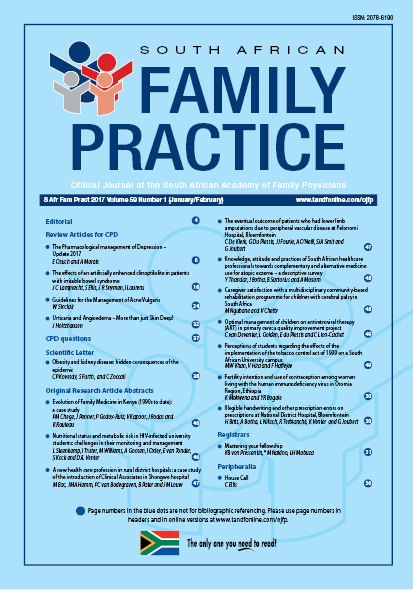A new health care profession in rural district hospitals: a case study of the introduction of Clinical Associates in Shongwe hospital
Keywords:
clinical associates, primary health care team, rural health, task sharing
Abstract
Background: One of the reasons to develop training courses for medical mid-level workers in South Africa is a shortage of doctors. The introduction of this new profession has led to task sharing and redefining of professional boundaries. The primary aim of this study is to evaluate the introduction of new healthcare professionals in a rural hospital district. Methods: This multi-method qualitative research study used a semi-structured questionnaire to assess the effectiveness of Clinical Associates. A review of documents from 2012 to 2015 was done including a longitudinal study of the development of the Bachelor in Clinical Medical Practice (BCMP) programme at Shongwe hospital. Results: Three Clinical Associates in 2011 and six Clinical Associates in 2014 completed questionnaires. Student satisfaction increased as measured with the Med IQ tool. At the end of 2013 Shongwe Clinical Learning Centre (CLC) had improved from last position out of 17 CLCs in 2011 to position number eight in 2014. Casualty was run by Clinical Associates and during observations it became clear that Clinical Associates were able to take responsibility for outpatient departments (OPDs), the emergency unit and some wards with supervision by a doctor. Conclusion: The introduction of the BCMP programme and the establishment of a Clinical Learning Centre in Shongwe hospital have led to improved patient care and a more conducive environment for teaching and learning. With the availability of more Clinical Associates vacant medical officer posts can be converted to employ Clinical Associates to serve patients without an increase in the cost of total human resources. (Full text of the research articles are available online at www.medpharm.tandfonline.com/ojfp) S Afr Fam Pract 2017; DOI: 10.1080/20786190.2016.1248144
Section
Original Research
By submitting manuscripts to SAFP, authors of original articles are assigning copyright to the South African Academy of Family Physicians. Copyright of review articles are assigned to the Publisher, Medpharm Publications (Pty) Ltd, unless otherwise specified. Authors may use their own work after publication without written permission, provided they acknowledge the original source. Individuals and academic institutions may freely copy and distribute articles published in SAFP for educational and research purposes without obtaining permission.

